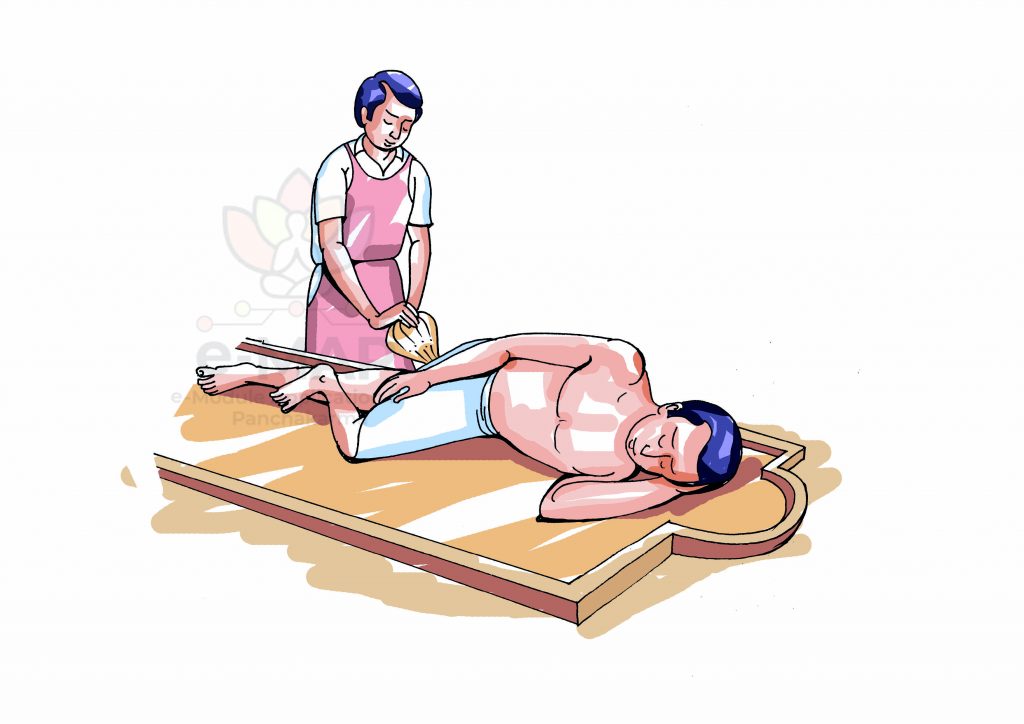
UG Module 6 - Lesson 10
BASTI KARMA

EXPLANATORY NOTES
NIRUKTI
- अनु+ वास+ल्युट्
- अनुवसति, अनुवासरंदीयते वा
Anuvāsana word derived from the root word ‘Vāsa’ with prefix ‘Anu’. The Basti is administered every day is called Anuvāsara.
अनुवसन्नापिनदूषयत्यनुपदवसंवादीयतेइपतअनुवासनम् (Su. Chi. 37/18)
That which doesn’t produce vitiation of Doṣa if retained in body or that which can be administered daily is called Anuvāsana.
Administration of different kinds of Sneha Dravya through the rectal route is known as Sneha Basti. Anuvāsana Basti is a type of Sneha Basti which can be used independently or in combination with Nirūha Basti as in Karma – Kāla – Yoga Basti Krama.
वातोल्बणेषु दोषेषु वाते वा बस्तिरिष्यते| (A. H. Su. 19/1)
Basti is indicated in increase of doṣas having predominance of Vāta or in increase of Vāta alone.
- य एवास्थाप्यास्त एवानुवास्याः; विशेषतस्तु रूक्षतीक्ष्णाग्नयः केवलवातरोगार्ताश्च; एतेषु ह्यनुवासनं प्रधानतममित्युक्तं मूले द्रुमप्रसेकवत्||
- आस्थाप्या एव चान्वास्या विशेषादतिवह्नयः|| रूक्षाः केवलवातार्ताः
Anuvāsana Basti is indicated in all the conditions where Āsthāpana Basti is indicated. Anuvāsana Basti is specially indicated for the persons having Rūkṣatha, Tīkṣṇagni and Kevala Vāta Roga.
In these conditions, Anuvāsana Basti is the foremost therapy. As sprinkling of water at the root helps in growth of the tree, similarly, administration of Anuvāsana Basti nourishes the body.
सर्वाङ्गैकाङ्गकुक्षिरोगवातवर्चोमूत्रशुक्रसङ्गबलवर्णमांसरेतःक्षयदोषाध्मानाङ्गसुप्तिक्रिमिकोष्ठोदावर्तशुद्धातिसारपर्वभेदाभितापप्लीहगुल्मशूलहृद्रोगभगन्दरोन्मादज्वरब्रध्नशिरःकर्णशूलहृदयपार्श्वपृष्ठकटीग्रहवेपनाक्षेपकगौरवातिलाघवरजःक्षयार्तविषमाग्निस्फिग्जानुजङ्घोरुगुल्फपार्ष्णिप्रपदयोनिबाह्वङ्गुलिस्तनान्तदन्तनखपर्वास्थिशूलशोषस्तम्भान्त्रकूजपरिकर्तिकाल्पाल्पसशब्दोग्रगन्धोत्थानादयो वातव्याधयो विशेषेण महारोगाध्यायोक्ताश्च
So, the common indications for Anuvāsana and Nirūha basti includes Sarvāṅga Roga, Ekāṅga Roga, Kukṣi Roga, Obstruction of Adho Vāta, Mūtra, Sukra and Purīṣa; Kṣaya and Doṣa of Bala, Varna, Māmsa, Sukra; Adhmāna, Anga Supti, Kṛmi Koṣṭha, Udāvarta, Shuddhātisāra, Parva- Bheda, Abhitāpa, Plihā roga, Gulma, Śūla, Hṛdroga, Bhagandara, Unmāda, Jvara, Bradhna, Śira Śūla, Karṇa Śūla, Kaṭī Graha, Vepana, Akṣipāka, Gaurava, Atilāghava, Raja kṣaya, Viṣamāgni; Śūla, Śoṣa, Sthambha of Sphik, Jānu, Jāṅgha, Uru, Gulpha, Pārṣṇi, Pāda, Yoni, Bāhu, Anguli, Stana, Danta, Nakha, Parva and Asthi; Āntra Kūjana, Parikartika; Alpālpa, Saśabda and Ugragandha Utthāna or Mala Pravartana.
According to Ācārya Bhela: – Kati, Prishta, Pārśva Roga, Udveṣṭana, Gulma, Vāta Vyādhi.
य एवानास्थाप्यास्त एवाननुवास्याः स्युः; विशेषतस्त्वभुक्तभक्तनवज्वरपाण्डुरोगकामलाप्रमेहार्शः प्रतिश्यायारोचकमन्दाग्निदुर्बलप्लीहकफोदरोरुस्तम्भवर्चोभेद विषगरपीतपित्तकफाभिष्यन्द गुरुकोष्ठश्लीपदगलगण्डापचिक्रिमिकोष्ठिनः
Anuvāsana Basti is prohibited in all the conditions for which Nirūha Basti is contra indicated.
अनास्थाप्यास्तुअजीर्ण्यतिस्निग्धपीतस्नेहोत्क्लिष्टदोषाल्पाग्नियानक्लान्तातिदुर्बलक्षुत्तृष्णाश्रमार्तातिकृशभुक्तभक्तपीतोदकवमितविरिक्तकृतनस्तःकर्मकुद्धभीतमत्तमूर्च्छितप्रसक्तच्छर्दिनिष्ठीविकाश्वासकासहिक्काबद्धच्छिद्रोदकोदराध्मानालसकविसूचिकामप्रजातामातिसार– मधुमेहकुष्ठार्ताः
So, the common contra indications for Anuvāsana and Nirūha Basti include Ajīrṇa, Atisnigdha, Pīta Sneha, Utkliṣṭa Doṣa, Mandāgni, Yāna Klānta, Ati Durbala, Kshudārtha, Tṛṣṇārtha and Sramārtha, Ati Kṛśa and Pītodaka, Vamita, Virikta, Krita Nastah karma, Kruddha, Bhīta, Matta, Mūrchita, Prasakta Chardi, Niṣṭhīvana, Kāsa, Śvāsa, Hikka, Baddhodara, Chidrodara, Udakodara, Alasaka, Viṣūcikā, Āma Prajāta and Āmatisāra, Prameha and Kuṣṭa
It is specially contraindicated in the following conditions
Abhuktabhakta, Nava Jvara, Pāṇḍu roga, Kāmala, Prameha, Arśas, Pratisyāya, Arocaka, Mandāgni, Daurbalya, Plīhodara, Kaphodara, Uru Sthambha, Varccha Bheda, Viṣa and Gara Pīta, Pitta and Kapha Abhiṣyanda, Guru Koṣṭha, Slīpada, Galagaṇḍa, Apaci and Kṛmi Koṣṭha
RATIONALE BEHIND THE CONTRAINDICATIONS
तत्राभुक्तभक्तस्यानावृतमार्गत्वादूर्ध्वमतिवर्तते स्नेहः, नवज्वरपाण्डुरोगकामलाप्रमेहिणां दोषानुत्क्लिश्योदरञ्जनयेत्, अर्शसस्यार्शांस्यभिष्यन्द्याध्मानं कुर्यात्, अरोचकार्तस्यान्नगृद्धिं पुनर्हन्यात्, मन्दाग्निदुर्बलयोर्मन्दतरमग्निं कुर्यात्, प्रतिश्यायप्लीहादिमतां भृशमुत्क्लिष्टदोषाणां भूय एव दोषं वर्धयेत्; तस्मादेते नानुवास्याः (Cha. Si. 2/18)
SN | Ayogya | Vyāpat |
1 | Abhuktabhakta | तत्राभुक्तभक्तस्यानावृतमार्गत्वादूर्ध्वमतिवर्तते स्नेहः Dravya spreads to Ūrdhvamārga |
2 | Nava Jvara, Pāṇḍu Roga, Kāmala, Prameha | दोषानुत्क्लिश्योदरञ्जनयेत् Doshotklesha leading to Udara Roga |
3 | Arśas | अर्शसस्यार्शांस्यभिष्यन्द्याध्मानं कुर्यात् Abhiṣyanda in the Arśas leading to Ādhmāna |
4 | Arocaka | अरोचकार्तस्यान्नगृद्धिं पुनर्हन्यात् Further increase in anorexia |
5 | Mandāgni, Durbala | मन्दाग्निदुर्बलयोर्मन्दतरमग्निं कुर्यात् Reduces power of digestion |
6 | Pratisyāya and Plīhādi Roga | प्रतिश्यायप्लीहादिमतां भृशमुत्क्लिष्टदोषाणां भूय एव दोषं वर्धयेत् Further Doshotkleśa and condition worsens |
Anuvāsana Basti is classified into 3 depending on the Mātrā of the Sneha used in the Basti.
षट्पली तु भवेच्छ्रेष्ठा त्रिपली मध्यमा भवेत् |
कनीयस्यार्धपलिका त्रिधा मात्रानुवासने || (Su. Chi. 37/4, Ḍalhaṇa commentary)
Maximum dose of Sneha Basti | 1/4th of maximum Mātrā of Nirūha Basti | 6 Pala –300ml |
Anuvāsana Basti | ½ of maximum Mātrā of Sneha Basti | 3 Pala –150ml |
Mātrā Basti | ½ of maximum Mātrā of Anuvāsana Basti | 1 ½ Pala –75 ml |
According to Cakrapāṇi
षट्पली तु भवेज्ज्येष्ठा, मध्यमा त्रिपली भवेत्| कनीयसी सार्धपला त्रिधा मात्राऽनुवासने
(Cha. Si. 4/54, Cakrapāṇi commentary)
Maximum Dose | Pravara Mātrā | 6 Pala | 300 ml |
Medium Dose | Madhyama Mātrā | 3 Pala | 150 ml |
Minimum Dose | Avara Mātrā | 1.5 Pala | 75 ml |
According to Ācārya Caraka, Anuvāsana Basti is classified based on Doṣaharakarma
- Vātahara Anuvāsana Basti – eg: Anuvāsana basti with Bilva Taila
- Pittahara Anuvāsana basti – eg: Anuvāsana Basti with Jīvanīya Yamaka
- Kaphahara Anuvāsana Basti – eg: Anuvāsana Basti with Madana Taila
According to Kaśyapa there are two types of Anuvāsana Basti
- Mātrā and Sneha Basti
MĀTRĀ BASTI
- ह्रस्वायाः स्नेहमात्राया मात्राबस्तिः समो भवेत् (Cha. Si. 4/53)
- ह्रस्वया स्नेहपानस्य मात्रया योजितः समः मात्राबस्तिः स्मृतः (A. H. Su. 19/68)
According to Caraka and Vāgbhaṭa, the Sneha Basti with dose equivalent to the Hrasva Mātrā of Snehapana is called as Mātrā Basti.
- तस्यापि विकल्पोऽर्धार्धमात्रावकृष्टोऽपरिहार्यो मात्राबस्तिरिति (Su. Chi. 35/18)
According to Suśruta, Mātrā Basti is a type of Anuvāsana Basti and the dose is 1.5 Pala and can be administered without any restrictions.
According to Kaśyapa
Kanīyasī Mātrā | 1 Prakuncha |
Madhyama Mātrā | 1.5 Prakuncha |
Uttama Mātrā | 2 Pala |
For Bāla who is not on milk only diet | 0.5 Pala |
यथेष्टाहारचेष्टस्य सर्वकालं निरत्ययः| (Cha. Si. 4/53)
Mātrā Basti is a procedure which is not having any restrictions to food and regimen and it can be safely administered in all the seasons.
Indications of Mātrā Basti
कर्मव्यायामभाराध्वया(पा)नस्त्रीकर्षितेषु च|
दुर्बले वातभग्ने च मात्राबस्तिः सदा मतः| (Cha. Si. 4/52)
Mātrā Basti is always useful for persons emaciated by excess activities, excercise, carrying heavy load, long way-faring, riding vehicles or indulging in sexual intercourse with women and for persons who are weak and who are afflicted with Vātika diseases.
……………………………शीलनीयः सदा च सः|
बालवृद्धाध्वभारस्त्रीव्यायामासक्तचिन्तकैः||
वातभग्नाबलाल्पाग्निनृपेश्वरसुखात्मभिः| (A. H. Su. 19/68)
Mātrābasti can be practiced always in children, the aged, those who are habituated to long walking, carrying loads, indulging in sex, physical activities, those who thinks too much, who are suffering from diseases of Vāta, fractures, debility, weak digestive power, for kings, wealthy persons and in persons who lead a luxurious life.
Contraindications of Mātrā Basti
तथापि तौ नाजीर्णे योज्यौ न च दिवास्वप्नः सेव्यः|| (A. S. Su. 28/8)
Mātrā basti should not be administered in the person having Ajīrṇa and who indulges in Divāsvapna.
Benefits of Mātrā Basti
बल्यं सुखोपचर्यं च सुखं सृष्टपुरीषकृत्|
स्नेहमात्राविधानं हि बृंहणं वातरोगनुत्|| (Cha. Si. 4/54)
Mātrā Basti promotes strength and it can be administered without any strict regimental stipulations. It helps in easy voiding of stool. The Mātrā Basti which is a form of Anuvāsana Basti is nourishing and cures diseases caused by aggravated Vāta.
दोषघ्नो निष्परीहारो बल्यः सृष्टमलः सुखः| (A. H. Su. 19/69)
It conquers Doṣas and is without any strict regimental stipulations, gives strength, evacuates mala easily and is comfortable procedure.
IMPORTANT SLOKA
अनुवसन् अपि न दुष्यत्यनुदिवसं वा दीयत इत्यनुवासनः । (Su.Chi.35/18)
That which doesn’t produce vitiation of Doṣa if retained in body or that which can be administered daily is called Anuvāsana.
य एवास्थाप्यास्त एवानुवास्याः; विशेषतस्तु रूक्षतीक्ष्णाग्नयः केवलवातरोगार्ताश्च; || (Ch. Si. 2/19)
Anuvāsana Basti is indicated in all the conditions where Āsthāpana Basti is indicated. Anuvāsana Basti is specially indicated for the persons having Rūkṣatha, Tīkṣṇagni and Kevala Vāta Roga.
य एवानास्थाप्यास्त एवाननुवास्याः स्युः; विशेषतस्त्वभुक्तभक्तनवज्वरपाण्डुरोगकामलाप्रमेहार्शःप्रतिश्यायारोचकमन्दाग्निदुर्बलप्लीहकफोदरोरुस्तम्भवर्चोभेद- विषगरपीतपित्तकफाभिष्यन्दगुरुकोष्ठश्लीपदगलगण्डापचिक्रिमिकोष्ठिनः || (Ch. Si. 2/17)
Anuvāsana Basti is prohibited in all the conditions for which Nirūha Basti is contra indicated. It is specially contraindicated in conditions like Abhuktabhakta, Nava Jvara, Pāṇḍu Roga, Kāmala, Prameha, Arśas, Pratisyāya, Arocaka, Mandāgni, Daurbalya, Plīhodara, Kaphodara, Uru Sthambha, Varccha Bheda, Viṣa and Gara Pīta, Pitta and Kapha Abhiṣyanda, Guru Koṣṭha, Slīpada, Galagaṇḍa, Apaci and Kṛmi Koṣṭha
नानुवास्यास्त एव च |
येऽनास्थाप्यास्तथा पाण्डुकामलामेहपीनसाः||
निरन्नप्लीहविड्भेदिगुरुकोष्ठकफोदराः|
अभिष्यन्दिभृशस्थूलकृमिकोष्ठाढ्यमारुताः||
पीते विषे गरेऽपच्यां श्लीपदी गलगण्डवान् | (AH. Su. 19/7-8)
Persons contraindicated for Nirūha Basti are not eligible for Anuvāsana Basti also. It should not be administered in Pāṇḍu, Kāmala, Prameha, Pīnasa, Niranna, Plīha, Vidbheda, Guru Koṣṭha, Kaphodara, Abhiṣyanda, Bhṛśa Sthūla, Kṛmi koshta, Āḍhyavāta, Pītavisa, Gara, Apaci, Slīpada and Galagaṇḍa.
षट्पली तु भवेच्छ्रेष्ठा त्रिपली मध्यमा भवेत् |
कनीयस्यार्धपलिका त्रिधा मात्रानुवासने || (Su. Chi. 37/4, dalhana commentary)
Based on Mātrā, Anuvāsana Basti is of three types; Sneha Basti (Uttama Mātrā – 6 Pala), Anuvāsana Basti (Madhyama Mātrā – 3 Pala) and Mātrā Basti (Avara Mātrā – 1 ½ Pala).
कर्मव्यायामभाराध्वया(पा)नस्त्रीकर्षितेषु च |
दुर्बले वातभग्ने च मात्राबस्तिः सदा मतः ||
यथेष्टाहारचेष्टस्य सर्वकालं निरत्ययः|
ह्रस्वायाः स्नेहमात्राया मात्राबस्तिः समो भवेत् ||
बल्यं सुखोपचर्यं च सुखं सृष्टपुरीषकृत् |
स्नेहमात्राविधानं हि बृंहणं वातरोगनुत् || (Ch. Si. 4/52-54)
Mātrā Basti is always useful for persons emaciated by excess activities, exercise, carrying heavy load, long way-faring, riding vehicles or indulging in sexual intercourse with women and for persons who are weak and who are afflicted with Vātika diseases.
Mātrā Basti is a procedure which is not having any restrictions to food and regimen and it can be safely administered in all the seasons. The dose of Mātrā Basti is equal to the minimum dose of Snehapāna. Mātrā Basti promotes strength and it can be administered without any strict regimental stipulations. It helps in easy voiding of stool. The Mātrā Basti which is a form of Anuvāsana Basti is nourishing and cures diseases caused by aggravated Vāta.



